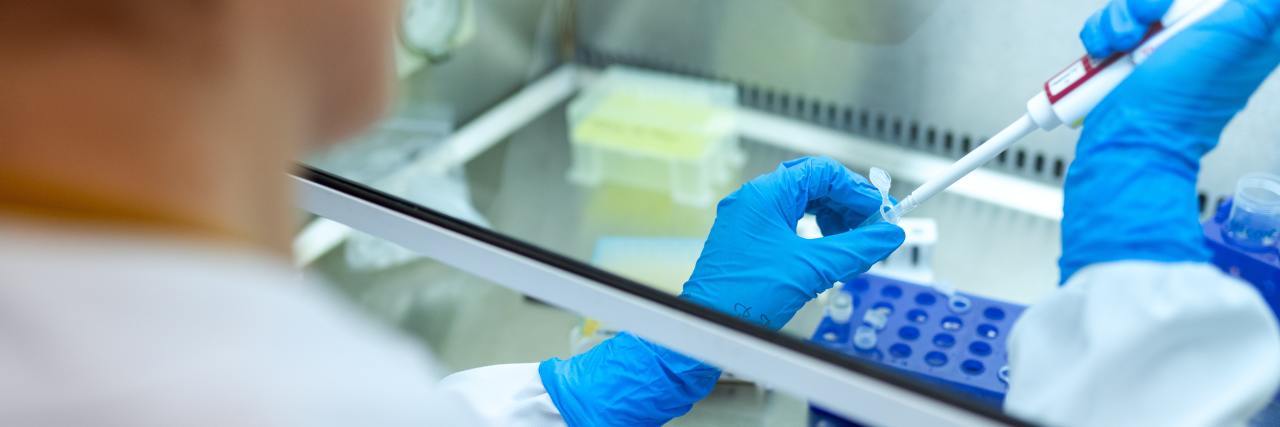The Industry Response to COVID-19 Is a Blueprint for Accelerating Rare Disease Treatments
Editor's Note
If you want to have a conversation with people who “get it,” join The Mighty’s Chat Space group.
On February 28, I stood on a crowded line waiting to pass through the Canadian border checkpoint at Montreal’s Trudeau Airport. Ordinarily I would have balked when an agent stopped to spray sanitizer on the hands of every passing traveler. Any other day I probably would have paused with concern when I saw border agents wearing N95 masks. I certainly should have questioned more when the Canadian customs agent asked twice if I had recently traveled to China. Any other day, I would have identified the increased precaution people were taking and sensed the palpable panic about to erupt. But on this day, I absorbed nothing — certainly not the possibility that a virus was about to disrupt civilization. On February 28, standing on a crowded line in a foreign country, I was numb and consumed with sadness. I was terrified the agent would ask me to remove my sunglasses only to reveal tears in my eyes. I was on my way to Lhassa’s funeral and thinking about what I would say to her father — a father who just lost his only daughter. Lhassa was a 5-year-old girl whose death was caused by KIF1A associated neurological disorder, the rare disease my daughter was diagnosed with in 2016. This would be the fourth funeral of a child with KIF1A I traveled to in as many years.
Like every family in our rare disease community, Lhassa’s has become an extension of my own. This community is bonded by a love so clear that even a language barrier could not delay the most painful conversation my job calls for; a conversation I have had seven times since our KIF1A families and doctors joined in a mission to find treatment for children living with this rare neurological disease. Hours before Lhassa died, I spoke with her mother — a conversation far too regular in the past four years, and a conversation that kills part of my soul every time. I explained to my close friend, as she held Lhassa in the final hours of her life, that an organ donation team was on call and ready to make an unimaginable process as seamless as possible. I asked Lhassa’s mom to donate her dying daughter’s brain and spinal cord to researchers in New York. We talked about how Lhassa would live on in science as an ever-present facilitator for researchers to understand KIF1A. I explained that studying the pathology of her daughter’s brain would allow researchers to discover treatment — a treatment that did not come in time for her own little girl. Words on this page will never describe the unfair and horrific trauma that accompanies those unthinkable end-of-life conversations with parents about to lose their child.

On February 28, I was standing on a crowded line at an international airport and thinking about my daughter, Susannah. I was thinking about Lhassa. I was thinking about children dying from rare neurological diseases. And I was crying. I did not notice that everybody around me was preparing for a catastrophic global pandemic.
COVID-19 ravaged the world. The impact on rare disease communities is beyond measure. For many rare disease patients and families, the global response to this crisis feels paradoxical.
On one hand, our rare disease community has been devastated by painful oversight, lack of care, and diminished quality of life. In parallel to this devastating impact on the rare disease community, in this pandemic, hope for faster discovery of cures has been dangled in front of us. Despite a president whose delay fueled fatality, the rare disease community has witnessed a swift industrial response and remarkable pace of research to develop COVID-19 treatments and diagnostics. The translational speed and medical blitz undertaken by industry to combat COVID- 19 is proof that treatments can get to patients much faster. COVID-19 proves that when innovators galvanize with focused resources and urgency, treatments are developed efficiently to save people who are dying of rare diseases.
An abhorrent lack of leadership is responsible for regression in people affected by degenerative diseases like KIF1A. Children with complex medical needs were forgotten as governments closed public schools. Students with disabilities who rely on services like physical therapy, occupational therapy, speech therapy, and other crucial interventions were sent home to isolation with no emergency action plan. Without consistent services, our children lose words, steps disappear, and skills vanish—skills that parents, therapists, and educators fight relentlessly to preserve.
These vital therapies do more than maintain and improve skills; they buy us time while we work to find treatments and cures. Critical medical appointments and medication changes are missed and standard of care has become an improvisation with little direction. If an emergency room visit is needed, lifesaving medical equipment is allocated elsewhere because our children are admitted alone, have cognitive delays, and are unable to communicate. People living with rare neurological diseases are suffering, and their lives have been de-prioritized because of this pandemic.
Foundations and advocacy groups work tirelessly to fund, support and accelerate discovery of treatment for rare diseases. In many instances, advocacy and family funding are primary sources for early scientific discovery. This integral preclinical research has been derailed as government and academic initiatives pivot to COVID-19. According to a webinar presented in April by Research America, “This has stopped scientific investigations that are essential to understanding, treating and curing countless diseases. Those studies have just been stopped, abruptly terminated, labs closed.” Discovery of rare disease treatment is an afterthought as academic labs are locked down, animal models euthanized, and precious patient-derived cell lines rendered inaccessible or even destroyed.
Amid this rare disease derailment, industry response to COVID-19 created a window of opportunity, and rare disease champions must act right now. This crisis triggered resources and workforce to spontaneously develop therapeutics for COVID-19. Biotech leaders executed in weeks what the rare disease community has been fighting for years to accomplish: diagnostics and therapeutics.
Families living with rare diseases know time is as much our enemy as nature. Every second together is fleeting, and COVID-19 forced the whole world to feel an identical terror; a terror that rare disease families live with daily. The emergency of COVID-19 induced a unified commitment and work ethic that, if scaled, will bring treatment to rare disease patients before time runs out. The heroism of people on front lines define our society, and previously underappreciated workers are rightfully recognized as the engine that drives progress — and saves countless lives. Now more than ever, together we are strong. A newfound global empathy has emerged for people suffering from catastrophic diseases with no treatments or cures.
Because of this global pandemic, humanity is teeming with science-driven empathy and commitment to every patient and family. My call to action for industry is clear: seize this opportunity. Do not abandon rare disease families. Attack rare disease therapeutics with the same relentless work ethic. Industry must act with continued vigor and utter urgency to accelerate treatments for rare diseases.
Biotech response to COVID-19 proves that the burden to accelerate treatments and cures for rare disease no longer falls solely on shoulders of parents, families, and advocates. Industry response to this pandemic is evidence that we can harness existing science, execute innovation, and bring treatments to rare disease patients exponentially faster. COVID-19 is a model and roadmap for accelerated rare disease research, development, approval, and access — a pathway of hope forged from a devastating medical crisis. A moment in time that will reveal the character of industry leaders.
To learn more about KIF1A, visit KIF1A.org
This story was originally published in Biotechnology in the Time of COVID-19: Commentaries from the Front Line, edited by Dr. Jeremy M. Levin.

